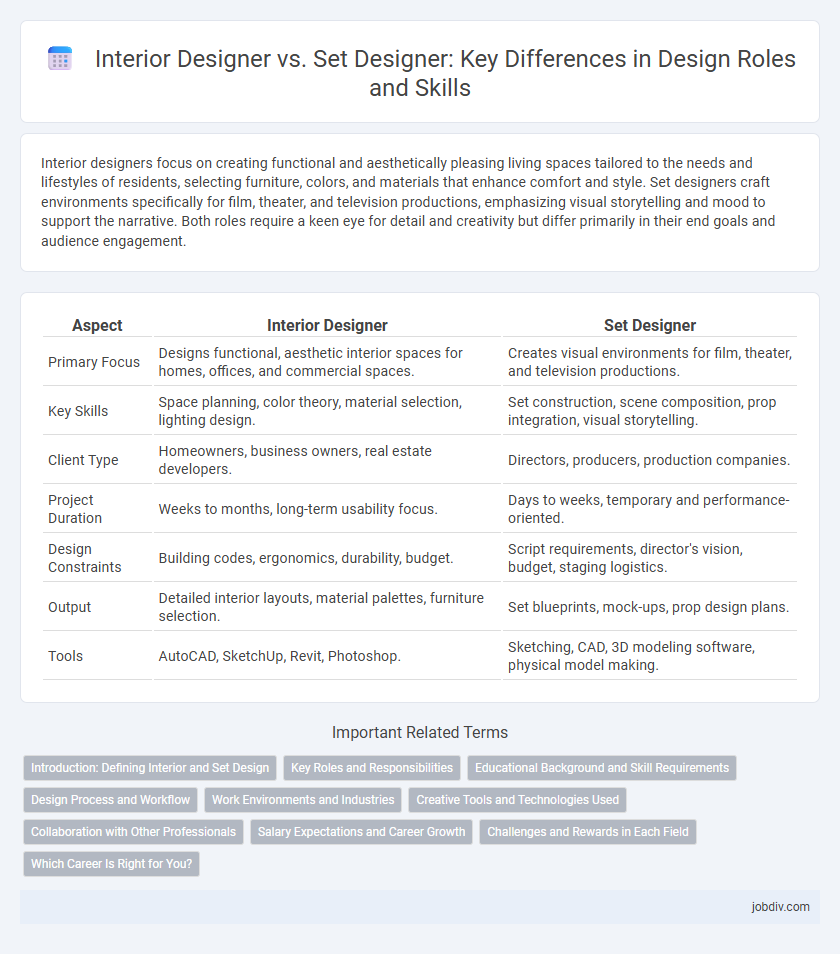Interior designers focus on creating functional and aesthetically pleasing living spaces tailored to the needs and lifestyles of residents, selecting furniture, colors, and materials that enhance comfort and style. Set designers craft environments specifically for film, theater, and television productions, emphasizing visual storytelling and mood to support the narrative. Both roles require a keen eye for detail and creativity but differ primarily in their end goals and audience engagement.
Table of Comparison
| Aspect | Interior Designer | Set Designer |
|---|---|---|
| Primary Focus | Designs functional, aesthetic interior spaces for homes, offices, and commercial spaces. | Creates visual environments for film, theater, and television productions. |
| Key Skills | Space planning, color theory, material selection, lighting design. | Set construction, scene composition, prop integration, visual storytelling. |
| Client Type | Homeowners, business owners, real estate developers. | Directors, producers, production companies. |
| Project Duration | Weeks to months, long-term usability focus. | Days to weeks, temporary and performance-oriented. |
| Design Constraints | Building codes, ergonomics, durability, budget. | Script requirements, director's vision, budget, staging logistics. |
| Output | Detailed interior layouts, material palettes, furniture selection. | Set blueprints, mock-ups, prop design plans. |
| Tools | AutoCAD, SketchUp, Revit, Photoshop. | Sketching, CAD, 3D modeling software, physical model making. |
Introduction: Defining Interior and Set Design
Interior design involves planning and enhancing indoor spaces to balance aesthetics, functionality, and comfort for everyday living or working environments. Set design focuses on creating immersive, temporary environments for film, theater, and television, emphasizing visual storytelling and mood. Both disciplines require a deep understanding of spatial composition, materials, and user experience but serve distinctly different purposes and audiences.
Key Roles and Responsibilities
Interior designers focus on creating functional and aesthetically pleasing indoor spaces, selecting furniture, colors, lighting, and materials to enhance living and working environments. Set designers specialize in designing and constructing physical settings for theatrical productions, films, or television, ensuring the space supports the story and mood while accommodating technical requirements. Both roles require strong spatial awareness and creativity, but interior designers prioritize long-term usability, while set designers emphasize temporary, narrative-driven environments.
Educational Background and Skill Requirements
Interior designers typically hold a degree in interior design or architecture, emphasizing spatial planning, color theory, and material knowledge, while set designers often study theater design or scenography with a focus on storytelling through environment and stage dynamics. Both require strong skills in drawing, 3D modeling software, and creative problem-solving, but interior designers prioritize functionality and client lifestyle, whereas set designers prioritize visual impact and narrative support. Understanding lighting design, construction techniques, and collaboration with other professionals is essential for success in both fields.
Design Process and Workflow
Interior designers focus on creating functional and aesthetically pleasing living spaces by selecting materials, furniture, and lighting that align with client needs and spatial constraints. Set designers develop temporary environments tailored for film, theater, or television productions, emphasizing narrative, scene requirements, and quick adaptability. Both workflows demand collaboration with clients and other professionals, but interior design entails long-term usability while set design prioritizes visual impact within tight production schedules.
Work Environments and Industries
Interior designers primarily work in residential, commercial, and hospitality environments, creating functional and aesthetically pleasing living and working spaces tailored to client needs. Set designers operate mainly in the entertainment industry, including film, theater, and television, crafting immersive and visually compelling environments that support storytelling. Both professions require collaboration with architects, directors, and clients but differ significantly in project timelines and spatial constraints.
Creative Tools and Technologies Used
Interior designers utilize CAD software, 3D rendering tools, and virtual reality to create functional and aesthetically pleasing living spaces tailored to client needs. Set designers often rely on drafting programs, model-building kits, and digital visualization software to conceptualize and construct immersive environments for film, theater, and television productions. Both professions increasingly incorporate augmented reality and parametric design technologies to enhance precision and creativity in their workflows.
Collaboration with Other Professionals
Interior designers collaborate closely with architects, contractors, and suppliers to ensure cohesive spatial planning and material selections that align with clients' functional and aesthetic goals. Set designers work in tandem with directors, lighting technicians, and costume designers to achieve a unified visual narrative and practical stage requirements. Both roles require effective communication and coordination with diverse teams to integrate creative and technical elements seamlessly.
Salary Expectations and Career Growth
Interior designers typically earn an average salary ranging from $50,000 to $75,000 annually, with potential growth as they gain experience and build a client base, often reaching six figures in high-demand markets. Set designers, especially those working in theater, film, and television, generally see starting salaries around $40,000 to $60,000 but can advance to higher pay brackets by securing roles on major productions or within established studios. Career growth for interior designers often involves expanding into luxury residential or commercial projects, while set designers may progress by taking on supervisory roles or specializing in complex, high-profile productions.
Challenges and Rewards in Each Field
Interior designers face the challenge of balancing aesthetics with functionality in diverse living and working spaces, often collaborating with architects and clients to create harmonious environments. Set designers encounter unique constraints of temporary, visually impactful settings, requiring rapid creativity and adaptability to support storytelling in theater, film, or television productions. Both fields reward professionals with the satisfaction of transforming spaces, whether enhancing everyday life or amplifying immersive artistic experiences.
Which Career Is Right for You?
Interior designers specialize in creating functional, aesthetically pleasing indoor environments by selecting color schemes, furniture, and lighting tailored to clients' lifestyles and architectural constraints. Set designers focus on constructing temporary, immersive spaces for theater, film, or television, emphasizing mood, narrative, and scene dynamics. Choosing between these careers depends on your passion for either permanent, client-centered living spaces or dynamic, storytelling-driven environments within entertainment production.
Interior Designer vs Set Designer Infographic

 jobdiv.com
jobdiv.com